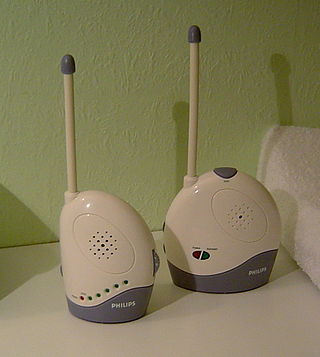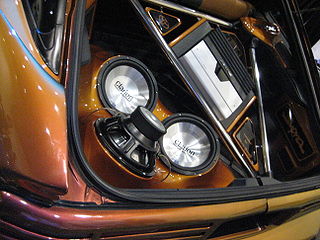The ISM radio bands are portions of the radio spectrum reserved internationally for industrial, scientific, and medical (ISM) purposes, excluding applications in telecommunications. Examples of applications for the use of radio frequency (RF) energy in these bands include RF heating, microwave ovens, and medical diathermy machines. The powerful emissions of these devices can create electromagnetic interference and disrupt radio communication using the same frequency, so these devices are limited to certain bands of frequencies. In general, communications equipment operating in ISM bands must tolerate any interference generated by ISM applications, and users have no regulatory protection from ISM device operation in these bands.
Radio frequency (RF) is the oscillation rate of an alternating electric current or voltage or of a magnetic, electric or electromagnetic field or mechanical system in the frequency range from around 20 kHz to around 300 GHz. This is roughly between the upper limit of audio frequencies and the lower limit of infrared frequencies, and also encompasses the microwave range, though other definitions treat microwaves as a separate band from RF. These are the frequencies at which energy from an oscillating current can radiate off a conductor into space as radio waves, so they are used in radio technology, among other uses. Different sources specify different upper and lower bounds for the frequency range.

In electronics and telecommunications, a radio transmitter or just transmitter is an electronic device which produces radio waves with an antenna with the purpose of signal transmission up to a radio receiver. The transmitter itself generates a radio frequency alternating current, which is applied to the antenna. When excited by this alternating current, the antenna radiates radio waves.
The S band is a designation by the Institute of Electrical and Electronics Engineers (IEEE) for a part of the microwave band of the electromagnetic spectrum covering frequencies from 2 to 4 gigahertz (GHz). Thus it crosses the conventional boundary between the UHF and SHF bands at 3.0 GHz. The S band is used by airport surveillance radar for air traffic control, weather radar, surface ship radar, and some communications satellites, especially those satellites used by NASA to communicate with the Space Shuttle and the International Space Station. The 10 cm radar short-band ranges roughly from 1.55 to 5.2 GHz. The S band also contains the 2.4–2.483 GHz ISM band, widely used for low power unlicensed microwave devices such as cordless phones, wireless headphones (Bluetooth), wireless networking (WiFi), garage door openers, keyless vehicle locks, baby monitors as well as for medical diathermy machines and microwave ovens. India's regional satellite navigation network (IRNSS) broadcasts on 2.483778 to 2.500278 GHz.

Mitsubishi Electric Corporation is a Japanese multinational electronics and electrical equipment manufacturing company headquartered in Tokyo, Japan. It was established in 1921 as a spin-off from the electrical machinery manufacturing business of Mitsubishi Shipbuilding at the Kobe Shipyard. The products from MELCO include elevators and escalators, high-end home appliances, air conditioning, factory automation systems, train systems, electric motors, pumps, semiconductors, digital signage, and satellites.
Netgear, Inc., is an American computer networking company based in San Jose, California, with offices in about 22 other countries. It produces networking hardware for consumers, businesses, and service providers. The company operates in three business segments: retail, commercial, and as a service provider.

A baby monitor, also known as a baby alarm, is a radio system used to remotely listen to sounds made by an infant. An audio monitor consists of a transmitter unit, equipped with a microphone, placed near to the child. It transmits the sounds by radio waves to a receiver unit with a speaker carried by, or near to, the person caring for the infant. Some baby monitors provide two-way communication which allows the parent to speak back to the baby. Some allow music to be played to the child. A monitor with a video camera and receiver is often called a baby cam.

Microwave transmission is the transmission of information by electromagnetic waves with wavelengths in the microwave frequency range of 300 MHz to 300 GHz of the electromagnetic spectrum. Microwave signals are normally limited to the line of sight, so long-distance transmission using these signals requires a series of repeaters forming a microwave relay network. It is possible to use microwave signals in over-the-horizon communications using tropospheric scatter, but such systems are expensive and generally used only in specialist roles.

The Faurecia Clarion Electronics Co., Ltd. is a Japanese manufacturer of car audio, automotive navigation systems, AutoPCs, visual equipment, bus equipment, and communication equipment. It is since 2019 fully owned by Faurecia Clarion Electronics.

A video sender is a device for transmitting domestic audio and video signals wirelessly from one location to another. It is most commonly used for sending the output of a source device, such as a satellite television decoder, to a television in another part of a property and provides an alternative to cable installations.

Radio is the technology of communicating using radio waves. Radio waves are electromagnetic waves of frequency between 3 hertz (Hz) and 300 gigahertz (GHz). They are generated by an electronic device called a transmitter connected to an antenna which radiates the waves. They are received by another antenna connected to a radio receiver. In addition to communication, radio is used for radar, radio navigation, remote control, remote sensing, and other applications.

A headset is a combination of headphone and microphone. Headsets connect over a telephone or to a computer, allowing the user to speak and listen while keeping both hands free. They are commonly used in customer service and technical support centers, where employees can converse with customers while typing information into a computer. They are also common among computer gamers and let them talk with each other and hear others while using their keyboards and mice to play the game.
LDMOS is a planar double-diffused MOSFET used in amplifiers, including microwave power amplifiers, RF power amplifiers and audio power amplifiers. These transistors are often fabricated on p/p+ silicon epitaxial layers. The fabrication of LDMOS devices mostly involves various ion-implantation and subsequent annealing cycles. As an example, the drift region of this power MOSFET is fabricated using up to three ion implantation sequences in order to achieve the appropriate doping profile needed to withstand high electric fields.
Wireless HDMI is the wireless transmission of high-definition audio and video signals between devices, using unlicensed radio frequencies like 5 GHz, 60 GHz, or 190 GHz. This technology eliminates the need for an HDMI cable, allowing users to transmit signals wirelessly between the component device and the display device. Wireless HDMI converts the HDMI cable signal into a radio frequency which is broadcast across the wireless spectrum. This allows for video source and display device to be in different rooms, without the need for cables. The technology emerged in the early 2000s.
Wireless Home Digital Interface (WHDI) is a consumer electronic specification for a wireless HDTV connectivity throughout the home.
There are several uses of the 2.4 GHz ISM radio band. Interference may occur between devices operating at 2.4 GHz. This article details the different users of the 2.4 GHz band, how they cause interference to other users and how they are prone to interference from other users.

Altra Industrial Motion is an American manufacturer of mechanical power transmission products – brakes, clutches, couplings, and the like. The company is headquartered in Braintree, Massachusetts.

Wireless security cameras are closed-circuit television (CCTV) cameras that transmit a video and audio signal to a wireless receiver through a radio band. Many wireless security cameras require at least one cable or wire for power; "wireless" refers to the transmission of video/audio. However, some wireless security cameras are battery-powered, making the cameras truly wireless from top to bottom.
'The Queen's Award for Enterprise: International Trade (Export) (2009)' was awarded on 21 April.